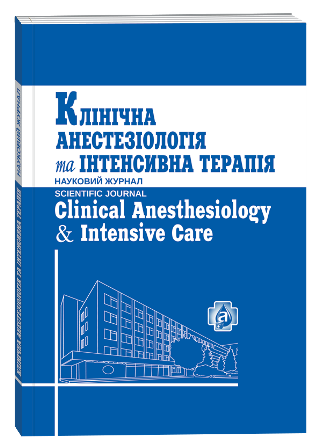THE EFFECTS OF ADEMOL ON THE FORMATION OF STEROI D NEUROTOXICITY BY THE LEVEL OF CORTISOL IN CONDITIONS OF MODELAL CURRENT BRAIN INJURY
DOI:
https://doi.org/10.31379/2411.2616.14.2.9Keywords:
traumatic brain injury, ademol, cortisol, steroid neurotoxicity.Abstract
One of the cellular targets for pathogenetic influence on the course of traumatic brain injury (TBI) is the use of pharmacological agents that are able to counteract the negative effects of excess concentrations of glucocorticoids (glucocorticoid neurotoxicity) on brain neurons in cerebral pathology. The goal of the work. To evaluate the effect of adamantane derivative 1-adamantylethyloxy-3-morpholino- 2-propanol hydrochloride (Ademol) in comparison with amantadine sulfate and 0.9% NaCl solution on the formation of steroidal neurotoxicity in rats with acute TBI. Materials and methods. The therapeutic effect of Ademol in rats with TBI was evaluated with a dose of 2 mg/kg (i\v) every 12 hours for 8 days. The pseudoperated animals and control group received 0.9% NaCl solution at a dose of 2 ml/kg (i\v), and the comparison group received amantadine sulfate at a dose of 5 mg/kg in the same mode. Cortisol levels were used to determine the efficacy of the test drugs in TBI. Results. Applied pharmacotherapy in the form of ademol and amantadine sulfate prevented an increase in blood cortisol levels in TBI animals, but its effectiveness depended on the drug selected. In rats treated with ademol (2 mg/kg), the level of cortisol in the blood ranged from 179 to 188 ng/ml (P5-P95) and was 2.58-fold lower (p<0.05) compared to control pathology group. Instead, the effect of amantadine sulfate (10 mg/kg) on the level of cortisol in the blood of the sagittal sinus was significantly less than that of ademol. Under these conditions, the concentration of cortisol in the blood ranged from 271-280 ng/ml (P5-P95), was 1.73 times lower (p<0.05), compared with the control pathology group, and by 49.2% (p<0.05) exceeded the corresponding value in animals treated with ademol. Conclusions. Therapeutic treatment of rats with severe TBI with a solution of 2 mg/kg ademol dose, preferably better than rats in the control pathology group with 0.9% NaCl and the group with amantadine sulfate promotes the formation of steroid neurotoxicity by cortisol, with overdose being cortisol the drug averaged 49.2% (p<0.05). One of the pathogenetic mechanisms of brain protective action in TBI is the ability of Ademol to correct the formation of steroidal neurotoxicity by cortisol levels in severe cerebral trauma.
References
Лапач СН, Чубенко АВ, Бабич ПН. Статистические методы в медико–биологических исследованиях с использованием Excel / К. : МОРИОН, 2000. – 320 с.
Пат. на винахід 106032 Україна, МПК (2014.01) С07С 13/615 (2006.01). Фармацевтична композиція 1–адамантилетокси–3–діетиламіно–2–пропанол гідрохлорид або його фармацевтично прийнятних солей для створення лікарських засобів для лікування цереброваскулярної патології патології / Загорій Г. В., Ходаківський О. А. ; заявник та патентовласник Загорій Г. В. ; № 106032; заявл. 24.12.2013; опубл. 10.07.2014, Бюл. № 13. – 4 с.
Дослідження впливу різних за якісним складом інфузійних розчинів на динаміку активності нейронспецифічної енолази хворих з гострим ішемічним інсультом / Семененко А.І. [та ін.] // Запорізький медичний журнал. – 2018. – 6(111). – C.757–761.
Ходаківський О.А. Порівняльна оцінка впливу похідних адамантану сполук ЮК–1 та ЮК–4 на активність NMDA–рецепторів / Ходаківський О.А. // Клін. фармація. – 2011. – №4. – С.60–63.
Ходаковский А.А., Маринич Л.И., Багаури О.В. Особенности формирования пост реперфузионного повреждения нейронов – характеристика модели «ишемия–реперфузия». Новые направления и перспективы развития современной церебропротекторной терапии ишемического инсульта / Ходаковский А.А., Маринич Л.И., Багаури О.В. // Врач– аспирант. – 2013. – №3(58). – С.69–76.
Порівняльна оцінка впливу адемолу та німодипіну на церебральну гемодинаміку в корі головного мозку за умов експериментального субарахноїдального крововиливу / Ходаківський О.А. [та ін.] // Світ медицини та біології. – 2016. –№3. – С.150–153.
Cortisol evaluation during the acute phase of traumatic brain injury–A prospective study / M. Bensalah [et al.] // Clin Endocrinol (Oxf). – 2018. – Vol.88 (5). – P.627–636.
A pharmacological screening approach for discovery of neuroprotective compounds in ischemic stroke / S. Beraki [et al.] // PLoS One. – 2013. –Vol.8 (7).
Guidelines for the Management of Severe Traumatic Brain Injury 4th Edition Reviewed for evidence–based integrity and endorsed by the American Association of Neurological Surgeons and the Congress of Neurological Surgeons / N. Carney [et al.] // Електронний ресурс. Посилання https://braintrauma.org/uploads/03/12/Guidelines for Management of Severe TBI 4th_Edition.pdf. [Дата останнього успішного входу 12 вересня 2016 року].
Management of severe traumatic brain injury (first 24hours) / T. Geeraerts [et al.] // Anaesth Crit Care Pain Med. – 2018. – Vol.37 (2). – P.171–186.
Management of Adult Traumatic Brain Injury: A Review / K. Janish [et al.] // Journal of Trauma & Treatment. – 2016. – Vol.5. – P.300–320.
A prospective neurosurgical registry evaluating the clinical care of traumatic brain injury patients presenting to Mulago National Referral Hospital in Uganda / B.J. Kuo [et al.] // PLoS One. – 2017. – Vol.12 (10). – P.182–185.
Effects of Age and Sex on Hospital Readmission in Traumatic Brain Injury / C.Y. Li[et al.] // PLoS One. – 2018. – Vol.17. – P.1466–1471. 14. Llompart-Pou, J.A., Pérez-Bárcena, J. Geriatric traumatic brain injury: An old challenge / J.A. Llompart-Pou, J. Pérez-Bárcena // Med Intensiva. –2019. – Vol.43 (1). – P.44-46.
Long, B., Koyfman, A. Secondary Gains: Advances in Neurotrauma Management / B. Long, A. Koyfman // Emerg Med Clin. – North Am. – 2018. – Vol.36 (1). – P.107–133.
M. J. Mac.Lullich, K. J. Ferguson, M. L. Reid. 11-hydroxysteroid dehydrogenase type 1, brain atrophy and cognitive decline / M. J. Mac.Lullich, K. J. Ferguson, M. L. Reid // Neurobiology of Aging. – 2012. – Vol. 33. – Р 207–207.
E. Rickels. Focus on traumatic brain injury / E. Rickels // Eur J Trauma Emerg Surg. – 2017. – Vol.43 (6). – P.729–730.
Correction of neurological deficiency in patients with acute ischemic stroke by application of different qualitative composition of infusion solutions / A.I. Semenenko [et al.] // Wiad Lek. – 2019. – LXXII(4). – P.543-547.







